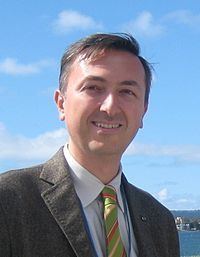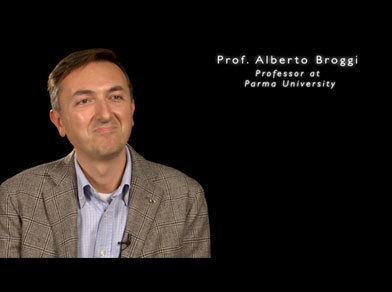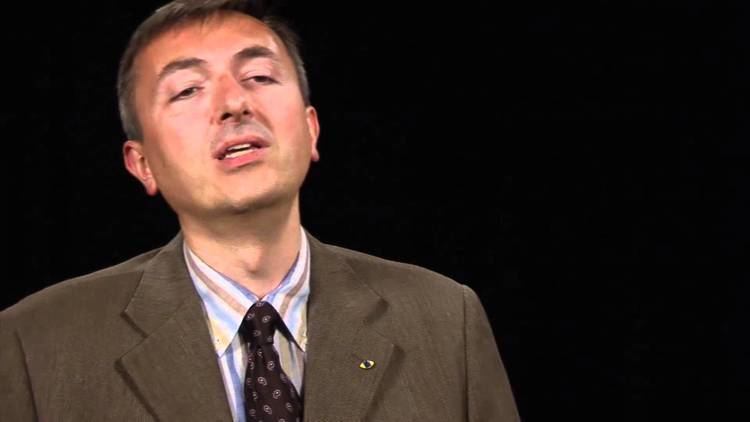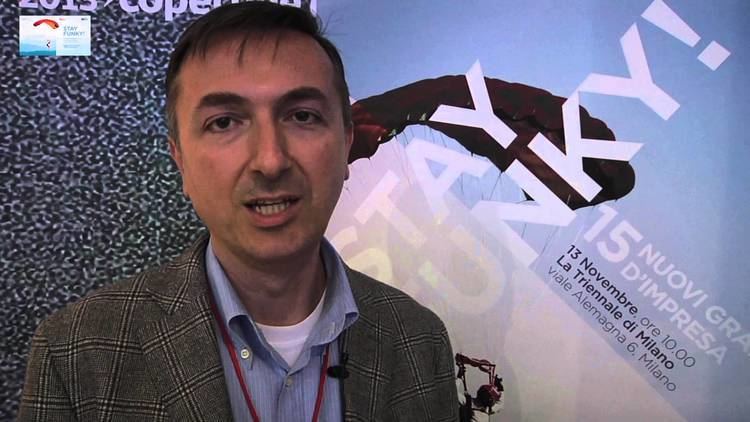Residence Italy | Name Alberto Broggi Nationality Italian | |
 | ||
Driverless car confessions alberto broggi
Alberto Broggi is General Manager at VisLab srl (spinoff of the University of Parma acquired by Silicon-Valley company Ambarella Inc. on June 2015) and a professor of Computer Engineering at the University of Parma in Italy, and has been pioneering the field of machine vision applied to driverless cars and unmanned vehicles in general.
Contents
- Driverless car confessions alberto broggi
- Automobile s ethics alberto broggi tedxmilano
- Biography
- Scientific Records
- Pioneering Work in Autonomous Driving
- Main Milestones
- Awards and honors
- References

Automobile s ethics alberto broggi tedxmilano
Biography

Alberto Broggi was born in Parma, Italy, in 1966. He studied electronic engineering at the University of Parma (1985–1990) and was the first person to get the degree in Electronic Engineering at the Faculty of Engineering of the University of Parma on Dec 20, 1990. Broggi got a position as Researcher at the Dipartimento di Ingegneria dell'Informazione, University of Parma in 1994; shortly after he got his PhD in Information Technology. In 1998 he was with the University of Pavia as an Associate Professor of Artificial Intelligence. From 2001 he has been Associate Professor and then Full Professor at the University of Parma, where he has been the founder and leader of the artificial vision research group, worldwide renown as VisLab.
Scientific Records

Broggi has been leading a number of worldwide publications as a founder or as an Editor. In particular he was the Founding Editor of a Regular Department on 'Intelligent Transportation Systems' of the IEEE Intelligent Systems Magazine (IEEE Computer Society) which he led from 1999 to 2003; and the Founding Editor of the IEEE Intelligent Transportation Systems Newsletter of the IEEE ITS Council first, and ITS Society after, which he led as Editor-in-Chief from 1999 to 2003 again. In 2004 he started serving the IEEE Transactions on ITS as Editor-in-Chief and resigned from this position in 2008 since -in 2009- he was elected President-elect of the IEEE ITS Society. He served the IEEE ITS Society as President for the term 2010-2011, and in 2012 he held the position of Past-President. He has been invited speaker and plenary speaker in a number of different conferences worldwide.
Pioneering Work in Autonomous Driving

Broggi's research activities started in the early ’90s, when very few laboratories worldwide were investigating the applicability of artificial vision on board of moving vehicles. At that time no hardware architecture was able to deliver sufficient processing power to run real-time image processing algorithms.
At that time (1991–1994) his group together with the Dipartimento di Elettronica, Politecnico di Torino, Italy, built their own hardware architecture (named PAPRICA, for PArallel PRocessor for Image Checking and Analysis, based on 256 single-bit processing elements working in SIMD fashion) and installed it on board of a mobile laboratory (Mob-Lab) to develop and test some initial concepts in the field of intelligent vehicles . These activities were funded by the EUREKA-project 'PROgraMme for a European Traffic of Highest Efficiency and Unprecedented Safety' (PROMETHEUS), which ended with a demonstration in October 1994, in France.
The experience on Mob-Lab not only provided the ground for new ideas on computer vision techniques, but the typical problems of the automotive environment were also investigated, creating a strong know-how on the application of artificial vision in the real world.
The time spent from 1990 to 1995 in developing, installing, and testing perception systems in a real automotive environment was of paramount importance and was a key factor for the growing of Broggi's reputation in the field.
In 1996 Broggi's entrepreneurial attitude triggered a very intriguing and challenging new activity that had to bring his research activities to a world-renowned level.
With very limited funding, Broggi's group worked to develop a real vehicle prototype (named ARGO, a Lancia Thema passenger car which was equipped with vision sensors, processing systems, and vehicle actuators) and developed the necessary software and hardware that made it able to drive autonomously on standard roads.
It was 1998; the processors offered by the market were Pentium 200 MHz; despite this, the 6-day-long demonstration of ARGO capabilities was a milestone and -thanks to an at-that-time innovative mobile link over which ARGO aired a live video stream from the vehicle- all the world was able to follow in real-time the results of that project, called MilleMiglia in Automatico. 94% of 2000+ km were driven autonomously; ARGO was able to follow the road, overtake slower traffic, locate obstacles, and follow the vehicle in front. This was the first experiment of a vehicle running autonomously with vision as the only sensor and a low cost off-the-shelf processing system.
Main Milestones
The first milestone was the completion of ARGO's test which then became one of the most cited examples globally in the Intelligent Vehicles field. Broggi's research group (called VisLab from then on) gathered all their findings in a book which was then also translated in Chinese.
Starting from these results, VisLab was offered a series of research opportunities by many car makers, automotive suppliers, research centers, and scientific research communities to bring its expertise and innovative flavor to a series of related applications. Given his visible position in the research arena, Broggi was asked to act as Program Chair of the main conference in this field (the IEEE Intelligent Vehicles Symp 2000 in Detroit) together with Jim Rillings (General Motors) as General Chair.
When Broggi was with the University of Pavia, his research was extended and applied to extreme conditions (automatic driving on snow and ice): in 2001, VisLab lead the challenging research effort of providing a vehicle (RAS, Robot Antartico di Superficie) with sensing capabilities so that it was able to automatically follow the vehicle in front. The vehicle was brought to the South Pole as a support to Italian scientific expeditions with the aim to automate the movement of goods from the Antarctic harbor to the Italian base.
VisLab also established a very strong relationship (2001–2005) with a car manufacturer in Wolfsburg, Germany, and provided research on applications such as pedestrian detection and night vision to increment road safety. At that time the research on pedestrian detection was just shaping up and VisLab’s contribution (using thermal imagery) marked the start of new investigations worldwide using this technology applied to commercial vehicles. Similar research topics (still very challenging and not yet solved) have been the basis for another research activity with US Army TARDEC, of which VisLab became a partner in 2001.
In 2004 Broggi was the General Chair of the IEEE Intelligent Vehicles Symp, which took place in Parma, and at the same time he was asked to act as Editor-in-Chief of the new scientific Journal sponsored by IEEE related to ITS research topics: the [[IEEE Transactions on Intelligent Transportation Systems]].
VisLab was asked to partner with many teams to take part in the DARPA Grand Challenge and DARPA Urban Challenge, namely races amongst autonomous vehicles that had to drive in different environments without any human intervention. VisLab took part in all 3 challenges (2004,’05,’07) and signed again the history of autonomous vehicles: in 2005 TerraMax (vehicle) -a 14 ton truck- was one of only 5 vehicles worldwide to win the challenge and reach the end of the 132 miles off-road race in the Mojave desert; in 2007 TerraMax was qualified for the DARPA Urban Challenge, 100 km of urban driving together with other vehicles. Thanks to these achievements, in December 2005 Broggi -together with Team Terramax- presented TerraMax the Pentagon in Washington, DC.
In January 2006, at the US Army base in Yuma, Arizona, VisLab -in partnership with Oshkosh Truck Corporation and Rockwell Collins- demonstrated a new prototype vehicle to the US military: a concept vehicle able to reach a predefined destination, unload, and get back to the starting point with no human intervention.
Other multinational companies such as TopCon and Caterpillar followed and started partnering with VisLab to explore new challenging opportunities, i.e. to integrate VisLab's sensing technologies on off-road vehicles (tractors, handlers, earthmovers,...).
In 2007 the Major of Parma awarded Broggi with a high recognition (‘for contributing in increasing the visibility of Parma’) and a local no-profit organization (Fondazione Cassa di Risparmio) decided to partially support VisLab activities; this contribution allowed VisLab to acquire a new vehicle, equip it with sensors, and continue the research. The vehicle's name is BRAiVE and soon became another milestone: with 10 cameras, 5 laserscanners, 16 laser beams, GPS, INS, and complete x-by-wire (provided by VisLab's partner MANDO, South Korea) BRAiVE flew to China in 2009 for the official presentation at the IEEE Intelligent Vehicles Symp 2009, where it demonstrated fully automatic features.
In 2008 Broggi was selected by ERC, European Research Council, to receive an Advanced Grant (about 2 million dollars) to support VisLab's research in the following 5 years.
In 2009, the same research group started a spinoff company, named VisLab srl, with the aim of transferring the technologies developed so far into products.
In 2010 Broggi's group embarked on driving 4 vehicles autonomously from Italy to China with no human intervention. This challenge is called VIAC, for VisLab Intercontinental Autonomous Challenge . VIAC has been presented in a number of conferences and symposia, with Broggi delivering plenary speeches. Soon after this, Broggi was awarded a second ERC grant (Proof of concept) to industrialize some of the results obtained and successfully tested on the VIAC vehicles.
On July 12, 2013, VisLab tested the BRAiVE vehicle in downtown Parma, negotiating two-way narrow rural roads, pedestrian crossings, traffic lights, artificial bumps, pedestrian areas, and tight roundabouts. The vehicle traveled from Parma University Campus up to Piazza della Pilotta (downtown Parma): a 20 minutes run in a real environment, together with real traffic at 11am on a working day, that required absolutely no human intervention. Part of this test was driven with nobody in the driver seat, for the first time ever on public roads.
